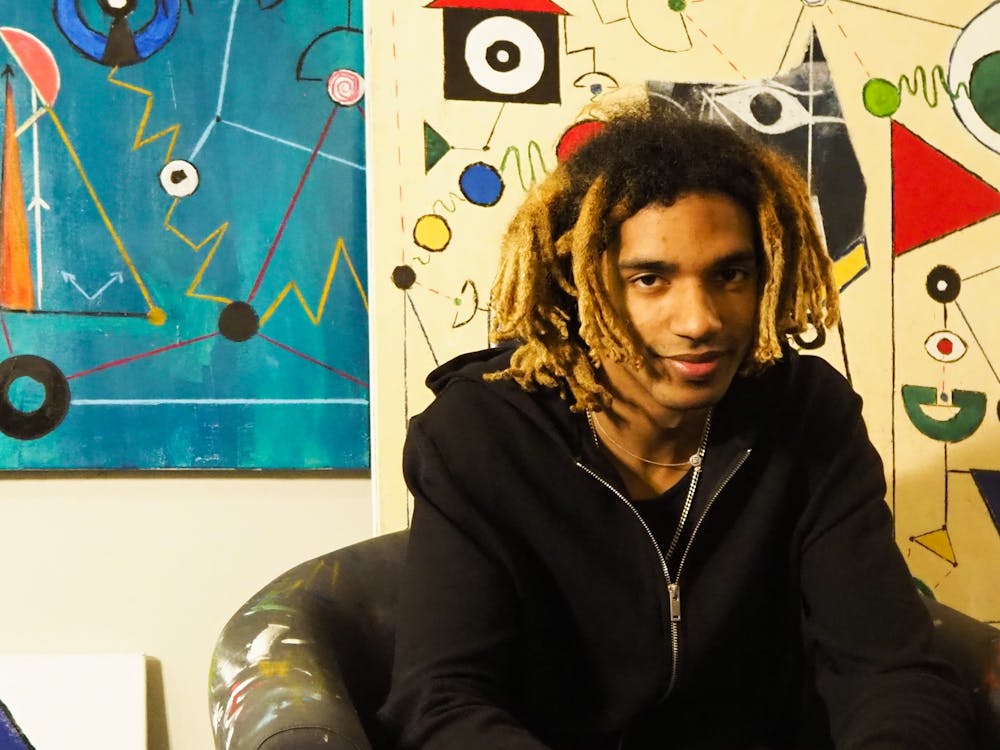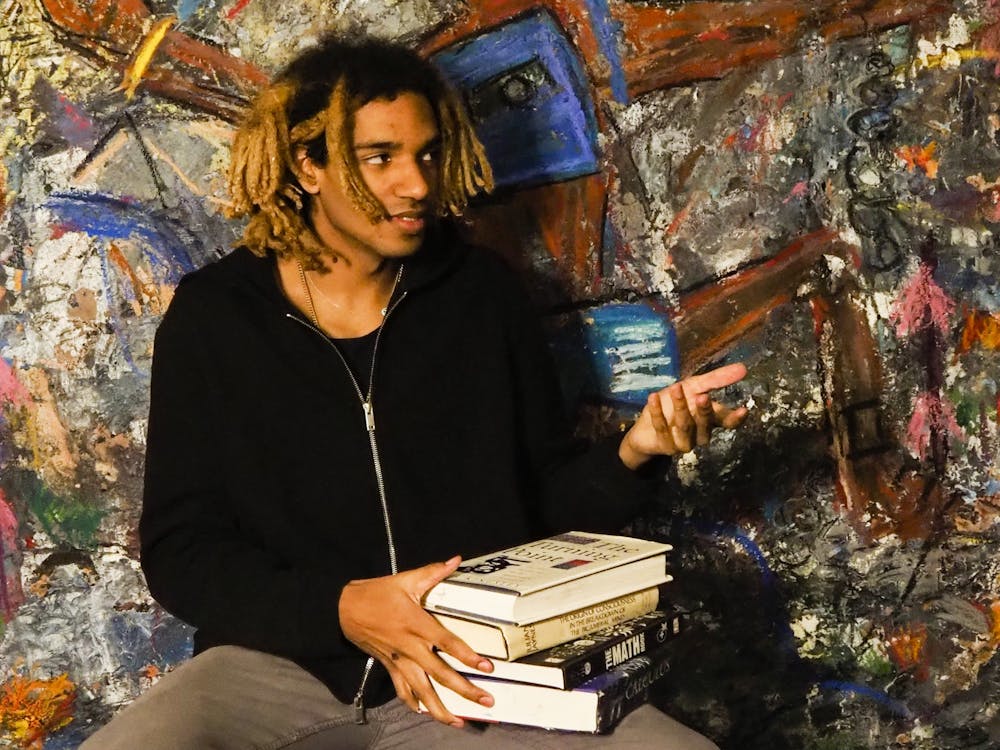Jet Le Parti (C '20) wasn’t supposed to be an artist.
Coming to Penn from what he describes as “a military family” in the small city of Columbus, Georgia, Jet’s first time in a museum was going to the Philadelphia Museum of Art in his first year of college.
This may be fitting, though. In Jet's world, art isn't just color on canvas—it’s simulation theory, the uncertainty principle, wormholes, and nonlocal quantum particles. When asked who has influenced his work, Jet named physicists, psychologists, inventors, and philosophers—“Carl Jung, David Deutsch, Max Tegmark, Friedrich Nietzsche, Martin Heidegger, Nikola Tesla." Not a single artist made the cut.
It didn’t take long to realize that Jet, the up–and–coming artist who is blowing up on social media, didn't see a difference between thinking about art and thinking about life. In fact, he believed them to be mutually inclusive. Refusing to take an art class at Penn, Jet would rather “learn as much as possible, listen to educated people, read their writings, and keep asking questions.”
“I've always had this imagination of what if you could step out of one universe and break it down and see another you and kinda take that place.” Now, in the second semester of his senior year, Jet has done just this. He has transformed his Radian apartment into a studio—paintings upon paintings line the walls, some hanging while others leaned against cluttered surfaces or were stacked on the ground. He stands in the center of his labyrinth, paint streaked across his clothes and his shoes an unrecognizable color. His friends from back home sit in the living room–turned–art–gallery behind him, one of them manning a DJ set, another photoshopping pictures, and a third setting up a camera to film the room. Loud techno music overpowers the already eccentric, sensory–overloaded gallery, adding a psychedelic feel to the scene.
His bedroom is no exception to the chaos, as pastels and jugs of paint dominate every surface of the space. A giant wall–sized canvas is the centerpiece, and Jet explains it has been repainted three times, left outside to the elements, and even been scraped with a rake.

We’ve now entered Jet’s universe, seemingly far away from Penn’s pre–professional culture, and even further away from the town with one museum that he was raised in.
“From a young age I asked a lot of questions, and the environment I was in just told me to go along with it, so I did that. I repressed it and I went along with it.” As Jet says this, he sits on a chair in his room next to a diverse collection of physics, philosophy, and math books. I remark that it’s rare for such a creative mind and free spirit to be so enamored with the definitive world of science. He doesn’t agree.
“When I grew up I thought people would have answers, but when I got to school I realized that no one really knows … so I’ve been exploring every avenue for an answer.” Prior to becoming an artist, he had wanted to be either a professor or philosopher. Yet, he found the world of academics to be limiting, creating the stalemate endemic to his whole life. “I thought, ok, so I've lost my mind. What do I do?”
Art was his release. Where words fall short, art never runs out of things to say. For someone who has taken a scholarly approach to life’s existential questions, it comes as little surprise that he refers to painting as “taking notes” and “breaking down the ongoing conversation in his head.”
“The way I imagine it is I can create these kinds of models and imaginary spaces and explore these ideas in different realms as I stay here.” His gallery reflects this—all the paintings are intentionally interconnected. “I'll leave doors within the painting to give the idea that entering it is a realm in which you enter another one.” He leaves other clues too, such as miniature versions of his other paintings in the backdrop of all his art, communicating the idea that they are all scenes in the same story. Sometimes, he even embeds secret messages in the form of binary code.
As he walks through the rationale behind one of his paintings, it's immediately clear that each brush stroke is deliberate, spawned from hours of close reading on quantum mechanics.
It wasn’t always like this. Jet found Penn through baseball, and through baseball, he found art. True to his theories of uncertainty, his career as an artist started in the most unlikely of places. While staying at a house in the Hamptons for a sports summer training, Jet encountered some art supplies in the basement and decided to give it a try. His Wednesdays off from baseball soon became art days, and it wasn’t long before there was no baseball altogether.

Jet’s last show of his college career is this Friday, February 21. Appropriately named “Taking Flight”—both a play on words of his name and a nod to his post–grad plans to live in an artist residency in Marseilles—the show is a testimony to how far he has come.
Regardless of how much he “plays the game,” Jet has not lost sight of his reasons for becoming an artist. “Ideally I'll get to a position where I just have to sell one or two pieces. I want to detach myself from the politics of art, but at the same time I have to pay rent and eat.”
Ultimately, he hopes that his gallery will provide an answer, or at the very least, a world in which it is okay to ask questions. “My end–all is to get my stuff into spaces where people like me can see it...all I really need to do is reach that one person.”
Jet, translating the binary code in a black and white painting he created in his earlier days, gives hope to all unlikely artists:
“Don’t worry, we’ve been here before. The hole is our home. We swim as we drown. Don’t worry about this, just see it through. I know it’ll be okay because I was once you too.”

